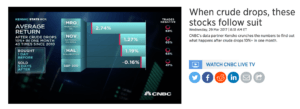Kensho: ‘Google-like’ search engine for financial analysis

Can future financial analysis be done by just posing questions?
Three years ago, if you googled AI-powered platform, Kensho would immediately pop out. It was the time before Goldman Sachs became a technology company, and the dawn of AI era (of financial industry). Found in 2013, Kensho was ‘out to do to financial analysis what Google did to search[1].’ It intended to provide the masses the type of quantitative analysis currently used by few top hedge funds. Recently, Kensho has finished a Series B funding led by S&P Global, which rises the valuation of company to 500 million[2].
What is Kensho?
Kensho has now achieved its goal partially and developed a software called Warren, which is similar to IBM’s Watson. Users, such as traders, can type a question in plain text into a ‘Google-style text box’. In return, Warren will put together an analysis with charts and tables to answer the question. For example, if one asks “Which Apple supplier’s share price goes up the most when the company releases a new iPad?’, Warren would search for the suppliers based on historical data, identify the one with the largest price increase, and summarize its findings into charts to support its answer and for further analysis.
From question to analysis, Warren performs in general two types of machine learning tasks. To understand the question, Warren performs text analysis with nature language processing techniques to identify key terms and parameters, such as events and companies in interest. Then, it pulls relevant historical data, performs a correlation analysis or event study to assess the impact of events on asset prices in the past, and summarizes its analysis into charts.
To power Warren’s analysis, Kensho has built a large database, “The Kensho Global Event Database”, which continuously and automatically collects and aggregates market information and data into one place[3]. Information and data are all publicly available and include texts, such as central bank announcements, product releases, and geopolitical events. With all the data cleaned, processed, and saved in one place, Kensho can easily perform many analyses at a fast pace.
Value Creation
Currently, Kensho has not opened its platform to mass investors, but it has been adopted by banks, such as Goldman Sachs and Bank of American, and media companies, such as CNBC[4]. It creates value because it can put together an timely analysis very fast. Traditionally, if an analyst want to assess an impact of an event, she needs to first search for data, then load and clean it, perform analysis, and finally present it with charts. A task that usually requires two days now just requires few clicks on Warren[5]. Because all the data is already in one place, it can be analyzed immediately with built-in analytics tool. Traders use Warren for a quick validation of their thesis, while fund managers use it for inspirations. It also allows CNBC to comments on a current event immediately by referring what happened historically.
Kensho differentiates itself from traditional data vendors, such as Thomson Reuters and Bloomberg, with a greater variety of data and built-in analytics tools. However, since all the data Kensho relies on is publicly available, it is not hard for traditional data vendors to catch up. In addition, the types of analysis done by Warren is still limited. Some of my friends, who work for banks that have adopted Warren, complain that they still need to download data and perform analysis themselves, since either Warren does not support the analysis or the analysis requires firm-specific private data.
Value Capture
Because all its clients are large institutions, Kensho may capture value by charging an annual service fee, which is similarly to its competitors. Employees of the clients can have access to Warren and use it as if they are using Bloomberg terminal or ThomsonOne. Kensho also prepares analysis report to its clients, such Forbes[6], as another type of service.
What’s next?
Kensho gets where it is now not only because of its solid AI technology but also first mover advantage. Back in 2013, Fed still ‘rel[ied] on Excel to analyze the economy[7]’, and financial institutions were not yet aware of the power of AI. Kensho broke the ice and builded its reputation as next ‘Google’ for financial analysis. Going forward, it will face more ‘tech-savvy’ clients and compete with other AI-powered platforms. Currently, it history-based inference can only act as a preliminary and quick analysis, and more sophisticated analysis is still needed for prudent investment. It can support more types of analysis and diversify its data further by including alternative data, such as satellite data, to differentiate. To stay relevant and irreplaceable, Kensho need increase the stickiness of their clients, such as provide tailored service by integrating firms own data into their software. Furthermore, Kensho can open its platform to individual investors globally.
Reference:
[1][7] Can Kensho bring google style search to stock picking? https://www.forbes.com/sites/stevenbertoni/2014/05/07/can-kensho-bring-google-style-search-to-stock-picking/#e2c7cb136ac3
[2][3] Kensho’s AI for investors just got valued at over $500 Million in funding round from Wall Street: https://www.forbes.com/sites/antoinegara/2017/02/28/kensho-sp-500-million-valuation-jpmorgan-morgan-stanley/#7aea7fc05cbf
[4] CNBC Kensho Stats Box: http://www.cnbc.com/kensho/
[5] The robots are coming for Wall Street: https://www.nytimes.com/2016/02/28/magazine/the-robots-are-coming-for-wall-street.html?_r=0
[6] In Donald Trumps first 100 days expect old economy stocks to keep winning: https://www.forbes.com/sites/antoinegara/2016/12/16/in-donald-trumps-first-100-days-expect-old-economy-stocks-to-keep-winning/#33cc567d1ebe



